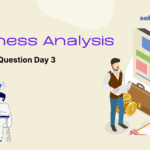Day 4: Data Analyst Interview Questions & Answers
Welcome back to Day 4 of our Data Analyst Interview Questions series! Today, we’re diving even deeper into the technical aspects of data analysis. Whether you’re preparing for an interview or simply looking to enhance your skills, these questions and answers will help you sharpen your expertise. Let’s jump right in:
Technical Questions with Answers:
1.What is the difference between supervised and unsupervised learning?
Answer: Supervised learning involves training a model on labeled data, where the algorithm learns to predict the output from the input data. Unsupervised learning, on the other hand, deals with unlabeled data where the algorithm tries to find patterns or relationships without explicit guidance.
2.Explain the concept of normalization in data preprocessing?
Answer: Normalization is the process of scaling numerical data to a standard range, usually between 0 and 1, to ensure that all features contribute equally to the analysis. It prevents features with larger scales from dominating the model’s learning process.
3.What is the purpose of a join operation in SQL?
Answer: Join operations in SQL are used to combine rows from two or more tables based on a related column between them. It allows us to retrieve data from multiple tables simultaneously, facilitating complex queries and analysis.
4.How do you handle missing values in a dataset?
Answer: Missing values can be handled by various techniques such as imputation (replacing missing values with a statistical estimate like mean or median), deletion (removing rows or columns with missing values), or using advanced algorithms that can handle missing data directly.
5.Explain the difference between correlation and covariance?
Answer: Covariance measures the extent to which two variables change together, whereas correlation measures both the strength and direction of the relationship between two variables. Correlation is a standardized measure, always ranging between -1 and 1, while covariance’s magnitude depends on the scale of the variables.
6.What is the purpose of using regularization in machine learning models?
Answer: Regularization is used to prevent overfitting in machine learning models by adding a penalty term to the cost function. It discourages overly complex models by penalizing large coefficients, thereby improving the model’s generalization performance on unseen data.
7.What are the key assumptions of linear regression?
Answer: The key assumptions of linear regression include linearity (relationship between independent and dependent variables is linear), independence of errors (residuals are independent of each other), homoscedasticity (constant variance of residuals), and normality of residuals.
8.Explain the concept of feature engineering in machine learning?
Answer: Feature engineering involves creating new features or transforming existing ones to improve the performance of machine learning models. It includes tasks such as encoding categorical variables, scaling numerical features, and creating interaction terms.
9.What is the purpose of a p-value in hypothesis testing?
Answer: The p-value represents the probability of obtaining test results as extreme as the observed results, assuming that the null hypothesis is true. It helps determine the statistical significance of the results and whether to reject the null hypothesis.
10.Describe the difference between a data warehouse and a data lake?
Answer: A data warehouse is a centralized repository for structured and processed data, optimized for querying and analysis. In contrast, a data lake is a storage repository that holds a vast amount of raw data in its native format until it’s needed, providing more flexibility for data exploration and analysis.
Case Studies Questions with Answers:
Scenario 1: You’ve been given a dataset with a high number of categorical variables. How would you approach encoding these variables for machine learning modeling?
Answer: For nominal categorical variables, I would use one-hot encoding to represent each category as a binary feature. For ordinal categorical variables, I might use ordinal encoding or create custom mappings based on the inherent order of the categories.
Scenario 2: Your company’s website experienced a sudden drop in user engagement. How would you use data analysis to diagnose the issue and propose solutions?
Answer: I would start by analysing website metrics such as page views, bounce rates, and user demographics to identify patterns or anomalies. I might also conduct A/B testing to compare different versions of the website and evaluate their impact on user engagement. Once the root cause is identified, I would collaborate with cross-functional teams to implement targeted solutions, such as improving website usability or content relevance.
Remember, the key to acing a data analyst interview is not just knowing the answers but also demonstrating your thought process and problem-solving skills. Stay curious, keep practicing, and you’ll be well-prepared for any interview challenge that comes your way!










